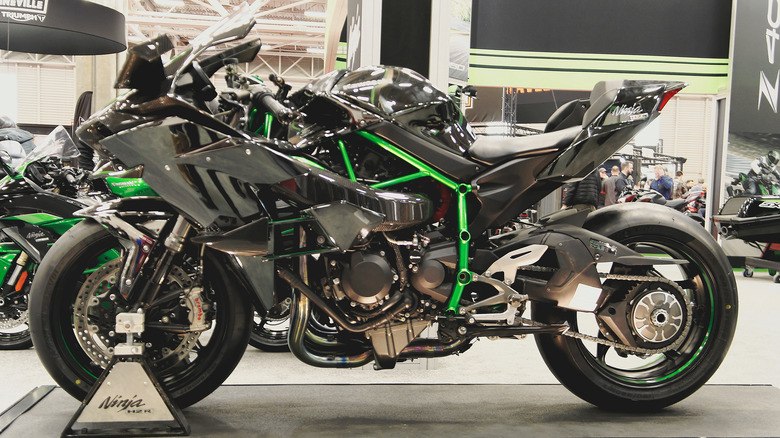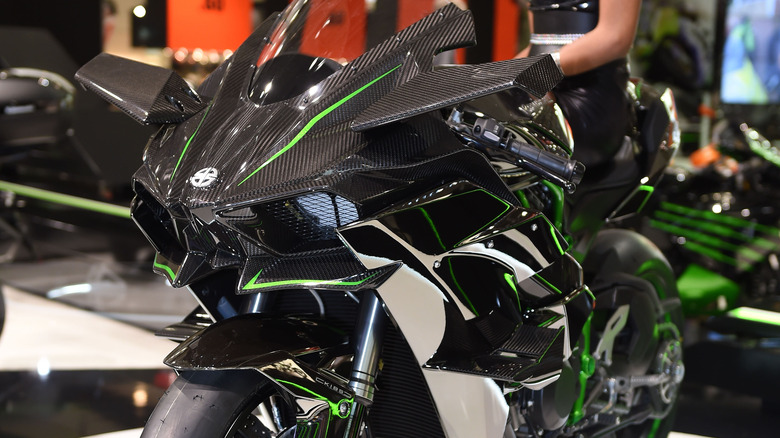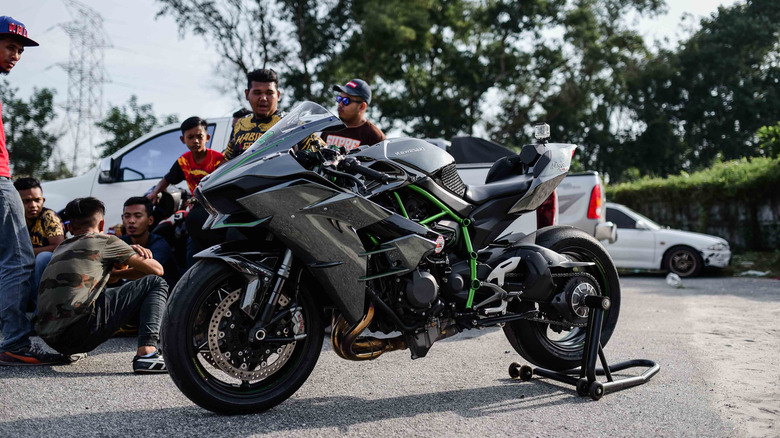
Apollo51x/Shutterstock
Kawasaki’s Ninja family conjures up images of swift speedsters with a bit of mystique, which held true from the first model. Development on that model, the 1984 GPZ900R, was approached with lofty goals: To provide astonishing performance without compromising drivability and introduce a motorcycle revolution beyond Kawasaki’s previous releases. To do this, Kawasaki developed a world-first liquid-cooled engine capable of 145 mph travel. The bike was reportedly designed over six years and kept under wraps throughout. The Ninja family would continue to innovate, introducing models like the unique Ninja H2R.
With superbikes, there’s often one key factor that enthusiasts want to hear about, one simple question to ask: How fast is it? The H2R absolutely does not disappoint in this regard. The ‘R’ in its name denotes that this is no street bike but a racing machine.
The H2R may culminate everything Kawasaki learned from creating Ninja motorcycles. Here’s a closer look at this powerful Kawasaki bike and exactly what sets it apart.
The stellar speed of the Ninja H2R
Marc Pfitzenreuter/Getty Images
In 2016, racing superstar Kenan Sofuoglu, who boasts the world record for most Supersport World Championship wins, set out to put the machine through its paces. True to form, he coaxed every last drop of speed from it in a record-breaking run across the Gulf of Izmit bridge.
Sofuoglu said, WorldSBK reports, that “four long months of training” went into the attempt and that the parameters for the H2R were clear: “Kawasaki said its maximum speed was 380 km/h (236 mph) and that their dream was to reach 400km/h (249 mph).” For a racer of his caliber, then, only 400 km/h would do. He achieved this pace in an early-morning run, a remarkable and rare speed that pushed the land record for a motorcycle in production.
“The top speed we get to in the world championship races is about 300 km/h (186 mph), so 400 km/h is a really high speed,” Sofuoglu said. At 2018’s Bonneville Speed Week, Team 38 achieved an average speed of 337.064 km/h (209 mph) to secure the sub-1,000 cc speed record in a Kawasaki H2, and the fact that the H2R model topped even this demonstrates exactly what it’s capable of. Even so, there’s much more to its specs than just an envelope-pushing top speed.
More of the motorcycle’s formidable specs and its street-legal sibling
Muhammad Afiq artz/Shutterstock
Speeds of around 400 km/h aren’t going to be attained very often, nor are they remotely practical from an everyday rider’s perspective. They’re certainly impressive, as are the machine’s other specs. At 12,500 rpm of torque and capable of outputting 14,000 rpm, the 2024 model is as mighty as ever.
For those who don’t just want to admire powerful bikes but ride them too, Kawasaki’s Ninja H2 is a model that isn’t restricted to race tracks. Of course, it’s not quite as potent as the H2R, but it’s certainly no slouch. Torque-wise, it weighs in at 10,500 rpm, and its power stands at 11,000 rpm. At 207 horsepower, it’s still quite powerful and perhaps a more tempting option without the sheer excess of its counterpart.
Another unique aspect of this powerful bike is the extent to which its design brought the engineers of Kawasaki together. The H2 family boasts a suite of technology, including the Kawasaki Engine Brake Control, Kawasaki Launch Control Mode, and Kawasaki Traction Control systems, suggesting a prioritization not only of speed but stability, too. Beyond that, some very special components of the bikes were Kawasaki-made, including the all-new swing arm and dog-ring transmission. Kawasaki’s Aerospace department created the mirrors.
The H2 family remains an aesthetically striking pair of bikes that are some of the fastest of all.
>>> Read full article>>>
Copyright for syndicated content belongs to the linked Source : SlashGear – https://www.slashgear.com/1490068/kawasaki-ninja-h2r-motorcycle-history/

































